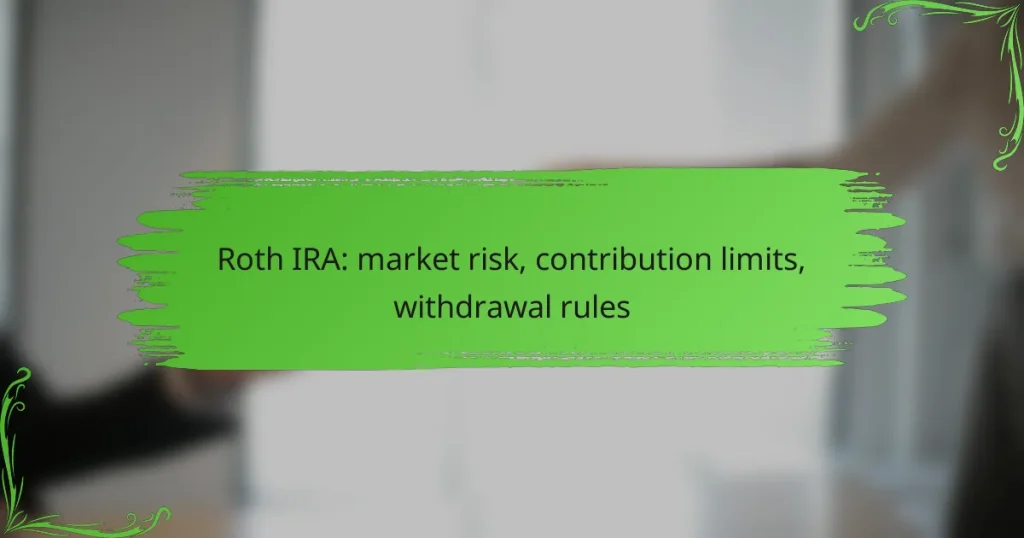A Roth IRA offers individuals a tax-advantaged way to save for retirement, but it comes with specific rules regarding contributions, market risks, and withdrawals. Contribution limits can vary annually based on income and individual circumstances, while market risk can affect the value of investments within the account. Additionally, understanding the rules for withdrawals is essential to avoid taxes and penalties, ensuring that your retirement savings are managed effectively.

What are the contribution limits for a Roth IRA in the UK?
The contribution limits for a Roth IRA in the UK are set annually and can vary based on individual circumstances. Generally, individuals can contribute a certain amount each tax year, but this may be reduced based on income levels and whether they are part of a couple.
Annual contribution limit for individuals
The annual contribution limit for individuals to a Roth IRA is typically set at a specific amount, which may change from year to year. For the tax year 2023, the limit is £20,000. This means that individuals can contribute up to this amount into their Roth IRA accounts without incurring any tax penalties.
It’s crucial to keep track of your contributions throughout the year to avoid exceeding this limit, as excess contributions can lead to penalties. Consider setting reminders or using financial tools to monitor your contributions effectively.
Contribution limits for couples
For couples, the contribution limits to a Roth IRA can be combined, allowing both partners to contribute to their individual accounts. Each spouse can contribute up to £20,000, resulting in a total potential contribution of £40,000 for the couple in a single tax year.
However, both partners must have sufficient earned income to justify the total contributions. If one spouse does not have earned income, the other can still contribute on their behalf, but the total combined contributions cannot exceed the limits set for each individual.
Income phase-out thresholds
Income phase-out thresholds determine the eligibility to contribute fully to a Roth IRA. For the tax year 2023, individuals with a modified adjusted gross income (MAGI) above £200,000 begin to see their contribution limits reduced, while those earning over £210,000 are ineligible to contribute directly.
Couples filing jointly face similar thresholds, with phase-out starting at a MAGI of £300,000 and complete ineligibility at £310,000. It’s essential to calculate your MAGI accurately to understand your contribution limits and plan accordingly.

How does market risk affect Roth IRA investments?
Market risk can significantly impact the performance of investments within a Roth IRA, as it encompasses the potential for losses due to fluctuations in market prices. Understanding these risks is crucial for making informed investment decisions and managing your retirement savings effectively.
Types of market risks
Market risks can be categorized into several types, including systematic risk and unsystematic risk. Systematic risk affects the entire market, such as economic downturns or changes in interest rates, while unsystematic risk is specific to individual investments, like a company’s poor performance.
Other types of market risks include currency risk, which can impact investments in foreign assets, and liquidity risk, where an investor may struggle to sell an asset without affecting its price. Recognizing these risks helps in diversifying investments within a Roth IRA.
Impact of market volatility
Market volatility can lead to significant fluctuations in the value of Roth IRA investments, affecting both short-term and long-term growth. During periods of high volatility, investors may experience rapid price changes, which can create anxiety and lead to impulsive decisions.
For instance, a sudden market downturn can decrease the value of stocks held in a Roth IRA, but it may also present buying opportunities for long-term investors. Understanding the nature of volatility allows investors to maintain a balanced perspective and stick to their investment strategies.
Risk management strategies
To manage market risk within a Roth IRA, investors can employ several strategies. Diversification is one of the most effective methods, spreading investments across various asset classes to reduce exposure to any single investment’s risk.
Additionally, regularly rebalancing the portfolio ensures that the asset allocation aligns with the investor’s risk tolerance and investment goals. Setting stop-loss orders can also help limit potential losses by automatically selling an asset when it reaches a certain price.

What are the withdrawal rules for a Roth IRA?
Withdrawals from a Roth IRA can be made under specific conditions, primarily categorized into qualified and non-qualified distributions. Understanding these rules is crucial for avoiding unnecessary taxes and penalties.
Qualified distributions
Qualified distributions from a Roth IRA are tax-free and penalty-free. To qualify, the account must be open for at least five years, and the withdrawal must occur under certain conditions, such as reaching age 59½, becoming disabled, or using the funds for a first-time home purchase (up to $10,000).
For example, if you are 60 years old and have held your Roth IRA for over five years, you can withdraw your contributions and earnings without incurring taxes or penalties.
Non-qualified distributions
Non-qualified distributions do not meet the criteria for tax-free withdrawal and may incur taxes and penalties. Generally, if you withdraw earnings before the age of 59½ or before the five-year holding period, you will face a 10% early withdrawal penalty and income tax on the earnings portion.
For instance, if you withdraw $15,000 from your Roth IRA, of which $5,000 is earnings and $10,000 is contributions, only the $5,000 would be subject to taxes and penalties if the distribution is non-qualified.
Tax implications on withdrawals
The tax implications of Roth IRA withdrawals depend on whether the distribution is qualified or non-qualified. Qualified distributions are entirely tax-free, while non-qualified distributions may incur income tax on earnings and a 10% penalty if taken early.
To avoid unexpected tax liabilities, it’s advisable to keep track of your contributions and the age of your account. Always consult a tax professional if unsure about your specific situation to ensure compliance with IRS regulations.

What are the benefits of a Roth IRA compared to other retirement accounts?
A Roth IRA offers unique advantages over traditional retirement accounts, primarily through tax-free growth and flexible withdrawal options. These features make it an appealing choice for individuals planning for retirement, especially those who expect to be in a higher tax bracket in the future.
Tax-free growth potential
One of the primary benefits of a Roth IRA is its tax-free growth potential. Contributions are made with after-tax dollars, meaning that any earnings on your investments grow tax-free. When you withdraw funds in retirement, you do not pay taxes on the withdrawals, provided certain conditions are met.
This can be particularly advantageous if your investments perform well over time. For example, if you contribute $6,000 annually and your investments grow at an average annual rate of 7%, your account could potentially grow significantly over several decades, all without tax implications on the gains.
Flexibility in withdrawals
Roth IRAs offer flexibility in withdrawals that many other retirement accounts do not. You can withdraw your contributions at any time without penalty or taxes, making it a useful option for those who may need access to funds before retirement. However, earnings can only be withdrawn tax-free after age 59½ and if the account has been open for at least five years.
This flexibility allows you to use your contributions for emergencies or significant expenses while still benefiting from the long-term growth of your investments. Just be cautious not to withdraw earnings prematurely to avoid taxes and penalties.
No required minimum distributions
Unlike traditional IRAs, Roth IRAs do not have required minimum distributions (RMDs) during the account holder’s lifetime. This means you can let your investments grow for as long as you want without being forced to withdraw funds at a certain age, which is typically 72 for traditional IRAs.
This feature is beneficial for those who wish to maximize their retirement savings or leave assets to heirs. By not having to take distributions, you can maintain control over your investments and potentially increase your wealth over time.

What factors should I consider when choosing investments for my Roth IRA?
When selecting investments for your Roth IRA, consider your risk tolerance, investment goals, and the need for diversification. These factors will help you build a portfolio that aligns with your financial objectives while managing potential market risks.
Risk tolerance assessment
Assessing your risk tolerance is crucial when investing in a Roth IRA. This involves understanding how much volatility you can handle in your investment portfolio without losing sleep. Generally, younger investors might opt for higher-risk investments, while those closer to retirement may prefer more stable, lower-risk options.
A simple way to evaluate your risk tolerance is to consider your investment timeline and financial goals. If you plan to use the funds in the near future, a conservative approach may be best. Conversely, if you have decades until retirement, you might choose to invest more aggressively.
Diversification strategies
Diversification is a key strategy for managing risk in your Roth IRA. By spreading your investments across various asset classes—such as stocks, bonds, and real estate—you can reduce the impact of poor performance in any single investment. A well-diversified portfolio typically includes a mix of domestic and international assets.
Consider using a combination of index funds and ETFs to achieve diversification efficiently. These investment vehicles allow you to invest in a broad range of securities, often at a lower cost than actively managed funds. Aim for a balanced allocation that reflects your risk tolerance and investment horizon.


